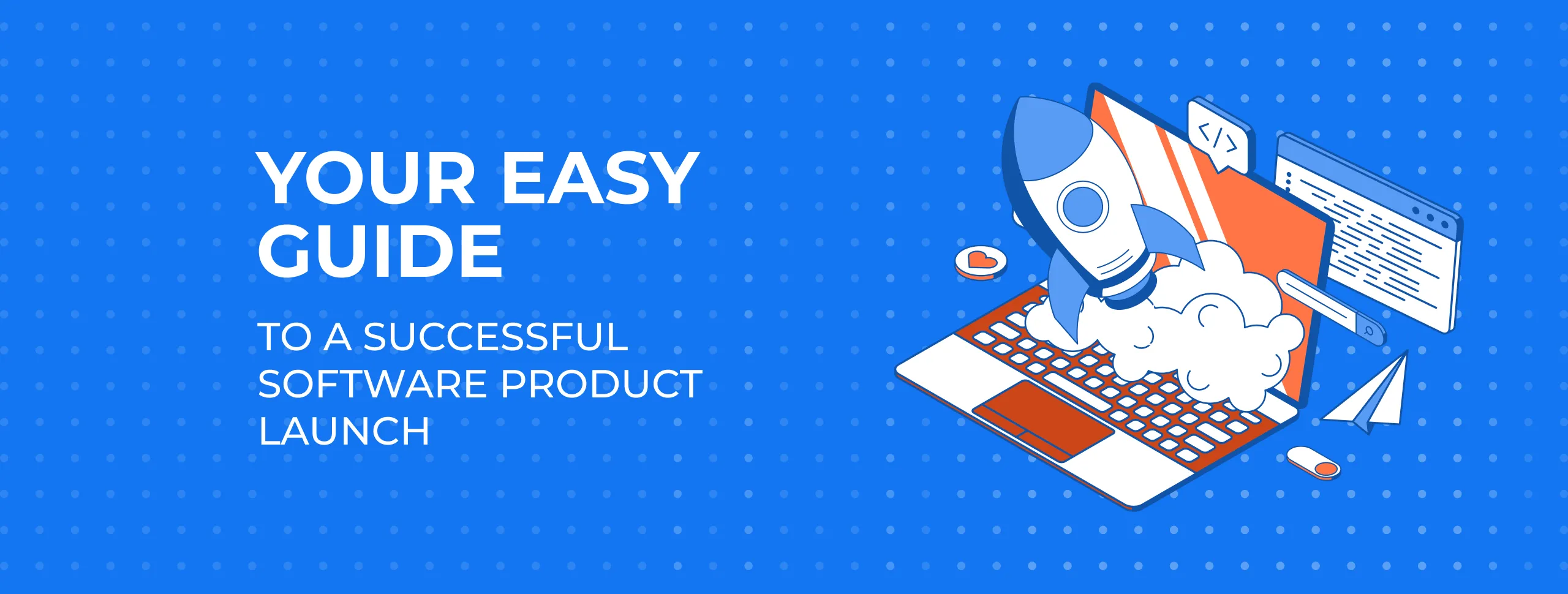
Your Step-by-Step Guide to a Successful Software Product Launch

Table of contents
- Key Steps to Follow for a Successful Software Product Launch
- Considerations for AI-Based Products
- Final Thoughts
Launching any software product is a big move. It’s the moment your idea goes from vision to reality. But software launches can be challenging; in fact, 32% of product failures stem from missteps during the launch phase. To ensure a smooth release, you’ll need a solid strategy, detailed planning, and a sharp focus on what matters most: delivering value to users.
Here’s how to work through the key stages of a successful launch, with added tips on handling the unique challenges of AI products.
Key Steps to Follow for a Successful Software Product Launch
Step 1: Craft a Strong Foundation for Your Product Launch
1. Value Over Features
Avoid feature overload. Instead, focus on understanding user needs. Start by identifying the key problems your software should solve. Build a roadmap that prioritises features addressing those real user challenges. Keep in mind, it’s not about adding every feature – it’s about delivering a solution that genuinely helps.
2. Agile Software Development and Quick Iteration
Agile methods let you test ideas early. Start with a Minimum Viable Product (MVP) or prototype. Gather feedback, then improve on it quickly. This helps you refine your product based on actual user input before a full release.
3. Cross-Functional Teamwork
A collaborative approach is key. Developers, designers, product managers, and QA teams should all work closely to make sure everyone’s aligned. By combining insights from each team, you’ll build a more cohesive, user-friendly product.
4. Manage Technical Risks
Plan for issues before they happen. Identify risks early, such as integration challenges or scalability concerns. Address them head-on by setting contingency plans in place. This proactive approach ensures your product will handle real-world demands smoothly.
5. Automated Testing and CI/CD Pipelines
Automate testing to speed up software development. Continuous Integration/Continuous Deployment (CI/CD) pipelines can streamline your release cycle, reducing errors while maintaining code quality. Your team can focus more on features and less on manual testing.
6. Monitoring and Backup Plans
Once live, you need robust monitoring. Set up logging, monitoring, and fallback options so any unexpected issues don’t interrupt the user experience. With these in place, you’ll be able to catch and address problems quickly.
Step 2: Know Why You’re Launching
Before you even think about launch day, clarify your “why.” Startups usually launch new products to:
-
Meet unmet customer needs with fresh, impactful solutions.
-
Build new revenue streams and drive business growth.
-
Stay ahead by leveraging new technology.
-
Expand into new markets or fields.
-
Improve efficiency for clients with streamlined digital tools.
Having clear goals from the beginning helps shape every decision, from feature planning to final rollout.
Step 3: Recognise Common Pitfalls (and How to Avoid Them)
Not every launch goes as planned. Here are some reasons why they sometimes don’t:
.webp)
-
Misunderstanding Requirements
If the product doesn’t align with business goals or user needs, adoption will suffer. Make sure you’re clear on both technical and business requirements from the start.
-
Overlooking Unique Value
Your product’s Unique Value Proposition (UVP) should be the guiding light. Without it, the product may get bogged down in unnecessary features that add little value.
-
Skipping Rigorous Testing
Launching with bugs or performance issues is a quick way to lose user trust. Test thoroughly to prevent post-launch problems.
-
Scope Creep
Extra features during development are tempting but often lead to delays. Stick to the planned scope, and add new features only if there’s time.
-
Ignoring Scalability
A product that can’t handle growth won’t last long. Design with scalability in mind from the beginning.
-
Skipping User Feedback Loops
Regular user feedback keeps your product relevant. Without it, you risk missing the mark on market fit.
Step 4: Build a Strong Launch Plan
Planning each detail keeps everyone on the same page and helps avoid last-minute issues. Here’s how to structure it:
-
Align with Key Events: Plan the launch around major events like trade shows or seasonal trends, if relevant.
-
Set Clear Milestones: Break the product into sprints with target milestones for each stage, from beta to full launch.
-
Scope Definition: Confirm the exact features to include in the MVP and make sure everyone understands the limitations.
-
Prepare the Support Team: Integrate support early so they’re equipped to handle user questions or issues.
-
Use a Phased Release: Gradually release the product to small user groups to catch any last-minute bugs.
-
Monitor and Improve: Track user feedback and KPIs to spot areas for improvement and iterate on updates.
Product Managers are vital throughout this process. They ensure that each step of the launch plan aligns with the product’s goals. From coordinating timelines to managing cross-functional teams, they ensure the launch stays on track.
Step 5: Follow the Stages of a Product Launch
A structured software development process keeps everyone on track. Effective software product lifecycle management involves moving through each phase with clear goals and priorities. Here’s the flow we recommend to guide your team from planning and prototyping to post-launch monitoring.

1. Ideation and Discovery
Start with a solid foundation by connecting with stakeholders. Clarifying the product’s purpose, audience, and goals early on helps everyone see the big picture. Checking technical feasibility upfront is key; it’ll save you from unexpected roadblocks later. For more insights on this important first step, check out our article on the Discovery Phase.
2. Planning and Prototyping
This is where ideas start taking shape. Begin with wireframes or an MVP to get a feel for how users respond. Gathering feedback now, even at this early stage, means you’re building something people actually want. Setting timelines and planning sprints also keeps everything on track.
3. Development and Testing
Now it’s time to bring your product to life. Develop iteratively so you can adapt quickly to feedback at every phase. And when it comes to testing, don’t hold back. Unit, integration, and regression tests are your best friends to make sure nothing slips through the cracks.
4. Pre-Launch Prep
Ready to go live? First, make sure your product can handle real traffic. UK software engineers recommend thorough load testing and verifying all third-party integrations to avoid launch-day surprises. Check that all APIs and third-party tools are good to go, and set up monitoring so you’re fully prepared to spot and tackle any issues that come up.
5. Launch
Deploy with confidence through your chosen platform, and automate where possible to keep things smooth. A soft or phased launch can be a smart move, letting you test the waters with a smaller group before diving in fully.
6. Post-Launch Monitoring
The launch isn’t the end; it’s just the beginning. Keep an eye on key performance indicators to see how the product holds up in real use. Use feedback and data to make updates, improve performance, and keep users happy.
Step 6: Tips for Marketing Your Launch
Even the best software needs visibility. Work with your marketing team to create a buzz:
-
Pre-Beta Teasers: Share demos or teaser videos to generate excitement. Let users sign up for beta access to build anticipation.
-
Beta Testing Programs: Invite early adopters to give feedback and spread the word.
-
Documentation and APIs: If you’re building a B2B or SaaS product, make sure to offer developer-friendly resources like API documentation to encourage integration.
Considerations for AI-Based Products
Launching an AI product comes with extra considerations, especially around compliance and data safety:
-
Data Privacy and Compliance
AI products often handle large amounts of personal data, so make sure your product complies with regulations like GDPR or CCPA if you’re operating internationally. For an example of how to overcome these challenges, check out our blog on Legal AI Software Development.
-
Bias Detection
Train your models carefully to avoid biases that could affect outcomes. Regularly audit your data to ensure fair and equitable AI solutions.
-
Model Explainability
Users and stakeholders need to understand how AI reaches its conclusions. Implement transparency features or dashboards that explain model decisions.
-
Scalability and Infrastructure
AI processing can be demanding on infrastructure. Optimise for scalability to handle increased data volumes without slowing down the product.
Final Thoughts
A successful software product launch goes beyond meeting deadlines or checking boxes. It's about creating real value for your users. To work through the complexities of each stage, partnering with a skilled software development company can be a real game-changer. Their expertise can guide you through the entire process, from development to launch, helping you stay focused on what matters: delivering a product that drives success.





